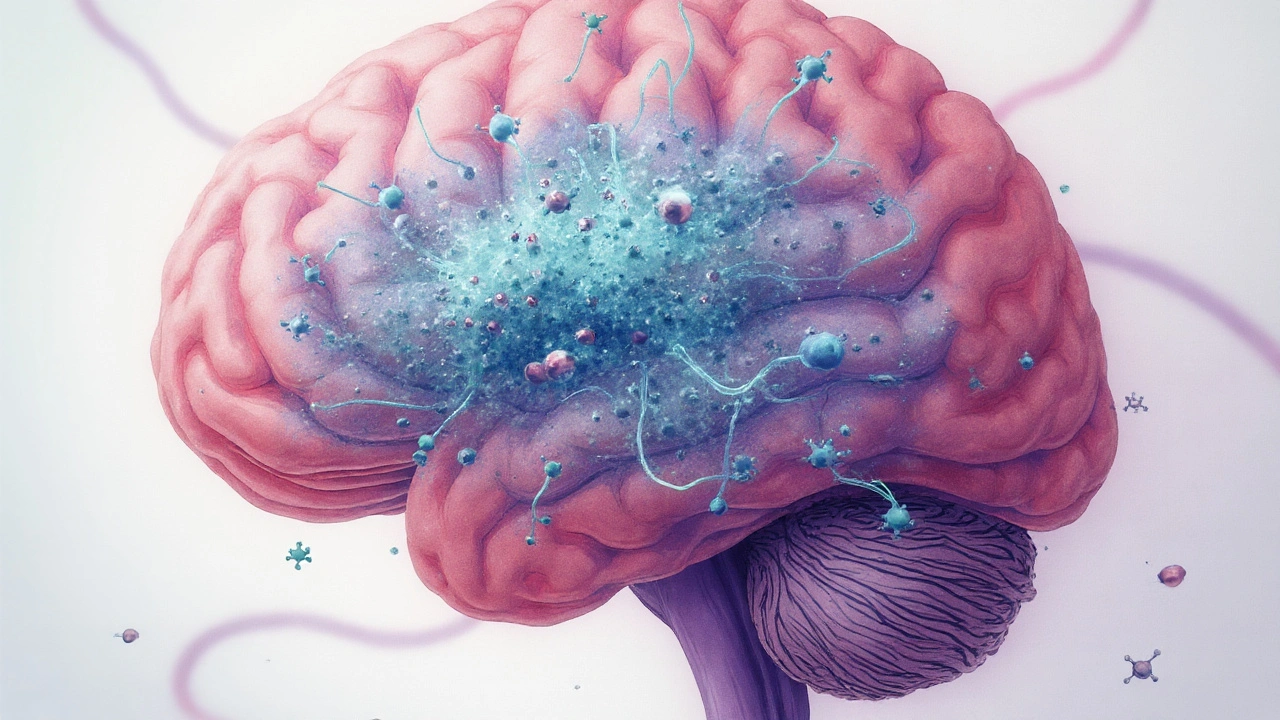Cefixime is a third‑generation oral cephalosporin used to treat a range of bacterial infections such as urinary‑tract infections, gonorrhoea and community‑acquired pneumonia. While it’s prized for its broad spectrum and convenient dosing, clinicians occasionally hear reports of strange neurological symptoms-headaches, dizziness, even seizures. Understanding why an antibiotic meant for the gut can sometimes knock on the brain’s door is essential for safe prescribing.
How Cefixime Works Inside the Body
The drug belongs to the cephalosporin family, a class that interferes with bacterial cell‑wall synthesis. By binding to penicillin‑binding proteins, cefixime prevents cross‑linking of peptidoglycan layers, leading to bacterial lysis. Its typical oral dose is 400mg once daily for most infections, but the exact amount depends on the pathogen, patient weight, and renal function.
Key pharmacokinetic attributes include:
- Absorption: about 90% bio‑available, reaching peak plasma levels in 2‑3hours.
- Distribution: predominantly extracellular; protein binding is ~50%.
- Excretion: 85% eliminated unchanged via the kidneys.
Because almost all of the drug surfaces in the urine, dosing errors in patients with impaired kidneys can cause systemic buildup-one of the main routes to neurological toxicity.
Crossing the Blood‑Brain Barrier
The blood‑brain barrier (BBB) protects the central nervous system (CNS) from most circulating substances. Cefixime’s chemical structure makes it relatively hydrophilic, so under normal conditions only trace amounts (<0.1% of plasma concentration) cross into the central nervous system. However, several scenarios can loosen this shield:
- Inflammation of the meninges (e.g., meningitis) increases BBB permeability.
- High plasma concentrations from overdose or renal failure raise the concentration gradient.
- Concurrent use of drugs that disrupt tight junctions (certain NSAIDs, steroids).
When the barrier relaxes, more cefixime can reach neuronal tissue, where it may interfere with neurotransmitter balance.
Neurological Side Effects Reported in Practice
Most patients never notice CNS involvement, but case series and post‑marketing surveillance have catalogued a handful of reactions:
- Seizures: usually tonic‑clonic, occurring within 24‑48hours of a high dose.
- Encephalopathy: confusion, disorientation, sometimes agitation.
- Peripheral neuropathy: tingling or burning in extremities.
- Psychiatric manifestations: anxiety, hallucinations, especially in the elderly.
Although these events are rare (estimated <0.05% of treated patients), they tend to cluster in people with the following risk factors:
- Renal impairment (creatinine clearance <30mL/min).
- Pre‑existing CNS disease (history of epilepsy, stroke).
- High‑dose regimens (e.g., 800mg twice daily for severe infections).
- Concurrent neurotoxic drugs (fluoroquinolones, carbapenems).
Why Does Cefixime Trigger Neurological Symptoms?
Exact mechanisms are still under investigation, but three leading theories dominate the literature:
- GABA antagonism: Cephalosporins can inhibit γ‑aminobutyric acid (GABA) receptors, lowering the brain’s primary inhibitory signal and tipping the balance toward excitation.
- Metal ion chelation: Some cephalosporins bind calcium and magnesium ions, subtly disrupting neuronal ion gradients vital for action potentials.
- Immune‑mediated inflammation: In rare cases, drug‑induced meningitis‑like inflammation raises BBB permeability, flooding the CNS with the drug.
Evidence from animal models supports the GABA‑antagonist hypothesis-administration of cefixime to rats reduced GABA‑evoked currents by up to 30% at concentrations comparable to those seen in renal failure.

Comparing Neurological Risk Across Common Antibiotics
Below is a quick look at how cefixime’s neurotoxicity profile stacks up against two frequently prescribed alternatives.
| Antibiotic | Typical CNS Penetration (%) | Reported Seizure Rate | Key Risk Modifiers |
|---|---|---|---|
| Cefixime | 0.1-0.3 | 0.5-1.0 | Renal failure, high dose |
| Azithromycin | 0.5-1.2 | 0.1-0.3 | Cardiac QT prolongation (not CNS) |
| Amoxicillin | 0.05-0.2 | 0.0-0.2 | Allergy, gut flora disruption |
While all three agents cross the BBB in minute amounts, cefixime’s seizure rate is modestly higher, especially when renal clearance drops. This table helps clinicians weigh options for patients already prone to CNS events.
Practical Steps to Mitigate Neurological Risks
When prescribing cefixime, consider the following checklist:
- Assess renal function: Calculate creatinine clearance; reduce the dose by 50% if <30mL/min.
- Screen for CNS history: Ask about prior seizures, stroke, or dementia.
- Review concurrent meds: Avoid combining with other GABA‑antagonists (e.g., fluoroquinolones) unless absolutely necessary.
- Educate patients: Explain warning signs-sudden dizziness, visual disturbances, or involuntary jerks.
- Monitor during therapy: For high‑risk individuals, schedule a follow‑up call 48hours after starting treatment.
- Have a rescue plan: If seizures occur, discontinue cefixime promptly and initiate benzodiazepine therapy per emergency protocols.
These steps echo the guidance from the U.S. Food and Drug Administration (FDA), which recommends dosage adjustment in renal impairment and vigilant observation for neurologic signs.
Related Concepts Worth Exploring
Understanding cefixime’s brain interaction opens doors to broader topics:
- Antibiotic stewardship: Choosing the narrowest‑spectrum agent can reduce unnecessary CNS exposure.
- Drug‑induced meningitis: Some beta‑lactams have been linked to sterile meningitis, a condition where inflammation mimics infection.
- Pharmacogenomics: Genetic variations in drug‑transport proteins (e.g., P‑gp) may affect how much cefixime reaches the CNS.
- Renal dosing calculators: Online tools help clinicians quickly tailor cefixime doses to kidney function.
Readers interested in the safety of other cephalosporins can look for posts about cefuroxime, ceftriaxone, and their respective CNS profiles.
Bottom Line
Cefixime is a reliable workhorse for many infections, but like any drug that passes even minutely through the blood‑brain barrier, it can spark neurological trouble under the right (or wrong) circumstances. By checking kidney health, reviewing a patient’s neurologic past, and staying alert to early warning signs, clinicians can keep the benefits high while the risks stay low.

Frequently Asked Questions
Can cefixime cause seizures in healthy adults?
Seizures are extremely rare in people with normal kidney function and no prior neurologic disease. The risk jumps when plasma levels climb-usually because of renal failure or dose overload.
What should I do if I experience a severe headache while taking cefixime?
A mild headache is common with many meds and may not signal a problem. However, if the pain is sudden, worsening, or accompanied by visual changes, contact your doctor right away. They may check blood levels or switch to a different antibiotic.
How is cefixime dosage adjusted for kidney disease?
For creatinine clearance <30mL/min, the usual 400mg once‑daily dose is halved to 200mg. Some guidelines suggest extending the interval to every 48hours for severe impairment. Always follow local renal‑dosing tables.
Are there safer alternatives for patients with a history of epilepsy?
Yes. Agents with minimal BBB penetration, such as amoxicillin or azithromycin, are often preferred. If a cephalosporin is unavoidable, choose a first‑generation drug at the lowest effective dose and monitor closely.
What does the FDA say about cefixime’s neurotoxicity?
The FDA’s label mentions rare cases of seizures, especially in patients with renal dysfunction. It advises dose reduction and vigilance for neurologic signs, aligning with the precautions outlined above.







Marshall Pope
September 22, 2025 AT 17:21Nonie Rebollido
September 24, 2025 AT 11:50Agha Nugraha
September 26, 2025 AT 06:02Andy Smith
September 26, 2025 AT 17:40Rekha Tiwari
September 27, 2025 AT 17:06Leah Beazy
September 28, 2025 AT 23:21John Villamayor
September 30, 2025 AT 10:18